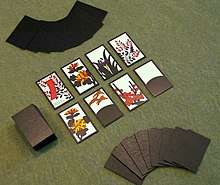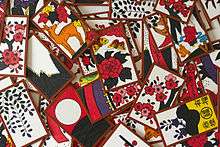Hanafuda
Hanafuda (花札) is a style of Japanese playing cards used to play a variety of games. Hanafuda translates to "flower cards".[1][2] The name also refers to some games played with the cards.


History
Playing cards were introduced to Japan by the Portuguese in the mid-16th century. The Portuguese deck consisted of 48 cards, four suits divided into 12 ranks. The first Japanese-made decks made during the Tenshō period (1573-92) mimicked Portuguese decks and are referred to as Tenshō Karuta. The main game was a trick-taking game intermediate in evolution between Triunfo and Ombre.[3] After Japan closed off all contact with the Western world in 1633, foreign playing cards were banned.[4]
In 1648, Tenshō Karuta were banned by the Tokugawa shogunate.[5] During prohibition, gambling with cards remained highly popular which led to disguised card designs. Each time gambling with a card deck of a particular design became too popular, the government banned it, which then prompted the creation of a new design. This cat and mouse game between the government and rebellious gamblers resulted in the creation of increasingly abstract and minimalist regional patterns (地方札). These designs were initially called Yomi Karuta after the popular Poch-like game of Yomi which was known by the 1680s.[6]
Through the Meiwa, An'ei, and Tenmei eras (roughly 1764–1789), a game called Mekuri took the place of Yomi. It became so popular that Yomi Karuta was renamed Mekuri Karuta.[6] Mechanically, Mekuri is similar to Chinese fishing games.[7] Cards became so commonly used for gambling that they were banned in 1791, during the Kansei era.
Hana Awase (hanafuda) appeared prior to 1816 when it was recorded as a banned gambling tool. Unlike earlier decks it consists of 12 months (suits) divided into four rank-like categories. The majority of hanafuda games are descended from Mekuri although Yomi adaptations for the flower cards survived until the 20th century.[6] Though they can still be used for gambling, its structure and design is less convenient than other decks such as Kabufuda. In the Meiji period, playing cards became tolerated by the authorities.
In 1889, Fusajiro Yamauchi founded Nintendo for the purposes of producing and selling hand-crafted hanafuda. Nintendo has focused on video games since the 1970s but continues to produce cards in Japan, including a few Mario-themed sets. Nintendo has licensed many third-party video game adaptations of hanafuda over the decades. The Koi-Koi game played with hanafuda cards is included in Nintendo's own Clubhouse Games (2006) for the Nintendo DS, and Clubhouse Games: 51 Worldwide Classics (2020) for the Nintendo Switch.
Outside of Japan
Hanafuda is sometimes played in the state of Hawaii in the United States and South Korea, though under different names. In Hawaii, there is Hawaiian-style Koi-Koi which is called Sakura, Higobana, and sometimes Hanafura. In South Korea, the cards are called Hwatu (Korean: 화투, Hanja: 花鬪); the name literally translates as battle of flowers. One of the most common Hwatu game is Go-stop (Korean: 고스톱)[8] or Seotda (Korean: 섯다). Hwatu is very commonly played in South Korea during special holidays such as the Lunar New Years, and also during the Korean holiday of Chuseok (추석). Playing Go-stop at holiday family gatherings has been a Korean tradition for many years. The Korean version is usually played with three players, with two-person variants. Hanafuda is also played in Micronesia, where it is known under the same name and is a four-person game, which is often paired cross-table.
Cards
There are twelve suits, representing months of the year. Each is designated by a flower and has four cards. The point values should be considered merely as a ranking mechanism, as the most popular games only concern themselves with certain combinations of taken cards.
| Month / Suit | Flower / Plant | Hikari (20-point card) | Tane (10-point card) | Tanzaku (5-point card) | Kasu (1-point card) |
|---|---|---|---|---|---|
| January | Pine | Crane and Sun | — | Poetry tanzaku | 2 cards |
| February | Plum blossom | — | Bush warbler | Poetry tanzaku | 2 cards |
| March | Cherry blossom | Curtain | — | Poetry tanzaku | 2 cards |
| April | Wisteria | — | Cuckoo | Plain tanzaku | 2 cards |
| May | Iris | — | Eight-plank bridge | Plain tanzaku | 2 cards |
| June | Peony | — | Butterflies | Blue tanzaku | 2 cards |
| July | Bush clover | — | Boar | Plain tanzaku | 2 cards |
| August | Susuki grass | Full moon | Geese | — | 2 cards |
| September | Chrysanthemum | — | Sake cup | Blue tanzaku | 2 cards |
| October | Maple | — | Deer | Blue tanzaku | 2 cards |
| November | Willow | Ono no Michikaze | Swallow | Plain tanzaku | Lightning |
| December | Paulownia | Chinese phoenix | — | — | 3 cards |
Some decks may have an extra card which could be blank (to draw a replacement) or feature a manufacturer's logo. In the Korean Hwatu version, the November and December suits are reversed. Hwatu may also include a variety of extra cards ranging in functionality, including 'service cards' (서비스 패) which award various bonuses.[9]
Card significance
- The January poetry tanzaku card has the phrase akayoroshi (あかよろし), employing the hentaigana character 𛀙 for the ka (可). The meaning of the phrase is currently unknown. It is theorized it might mean "明らかによろしい" – "obviously good."[10]
- The February poetry tanzaku card has the same phrase akayoroshi.
- The March poetry tanzaku card has the phrase Miyoshino (みよしの) referring to the place Miyoshino (美吉野) in Nara. The town is known for its cherry blossoms.
- The September sake cup card has the character for kotobuki (寿), meaning long life.
Games
Mekuri derived games:
- Hana Awase
- Minhwatu
- Koi-Koi
- Roppyakken
- Mushi
- Hachi
- Hachi-hachi
- Sudaoshi
- Tensho
Yomi derived games:
- Poka
- Hiyoko
- Isuri
Gabo Japgi/Kabufuda derived games:
- Seotda
- Doryjytgo-ttang
See also
- Category:Hanafuda manufacturers
- Kabufuda
- Karuta
- Uta-garuta
- Tazza: The High Rollers (or The War of Flower)
- Summer Wars
References
- "Games played with Flower Cards". www.pagat.com. Retrieved 20 December 2017.
- Pakarnian, John, "Game Boy: Glossary of Japanese Gambling Games", Metropolis, January 22, 2010, p. 15.
- Depaulis, Thierry (2009). "Playing the Game: Iberian Triumphs Worldwide". The Playing-Card. Vol 38-2, p. 134-137.
- Harris, Blake J., Console Wars: Sega, Nintendo, and the Battle that Defined a Generation, It Books, 2014-May-13. ISBN 978-0062276698. "Chapter 5"
- Mann, Sylvia; Wayland, Virginia (1973). The Dragons of Portugal. Farnham: Sanford. p. 46.
- Kuromiya Kimihiko. (2005). "Kakkuri: The Last Yomi Game of Japan". The Playing-Card, Vol 33-4. p. 232-235.
- McLeod, John; Dummett, Michael (1975). "Hachi-Hachi". The Playing-Card. 3 (4): 26–39.
- "Rules of Card Games: Go Stop". www.pagat.com. Retrieved 20 December 2017.
- "sloperama.com". www.sloperama.com. Retrieved 20 December 2017.
- "花札の謎シリーズ 赤短『あかよろし?』". Ohishi Tengudo.
External links
| Wikimedia Commons has media related to Hanafuda. |
| Look up hanafuda in Wiktionary, the free dictionary. |